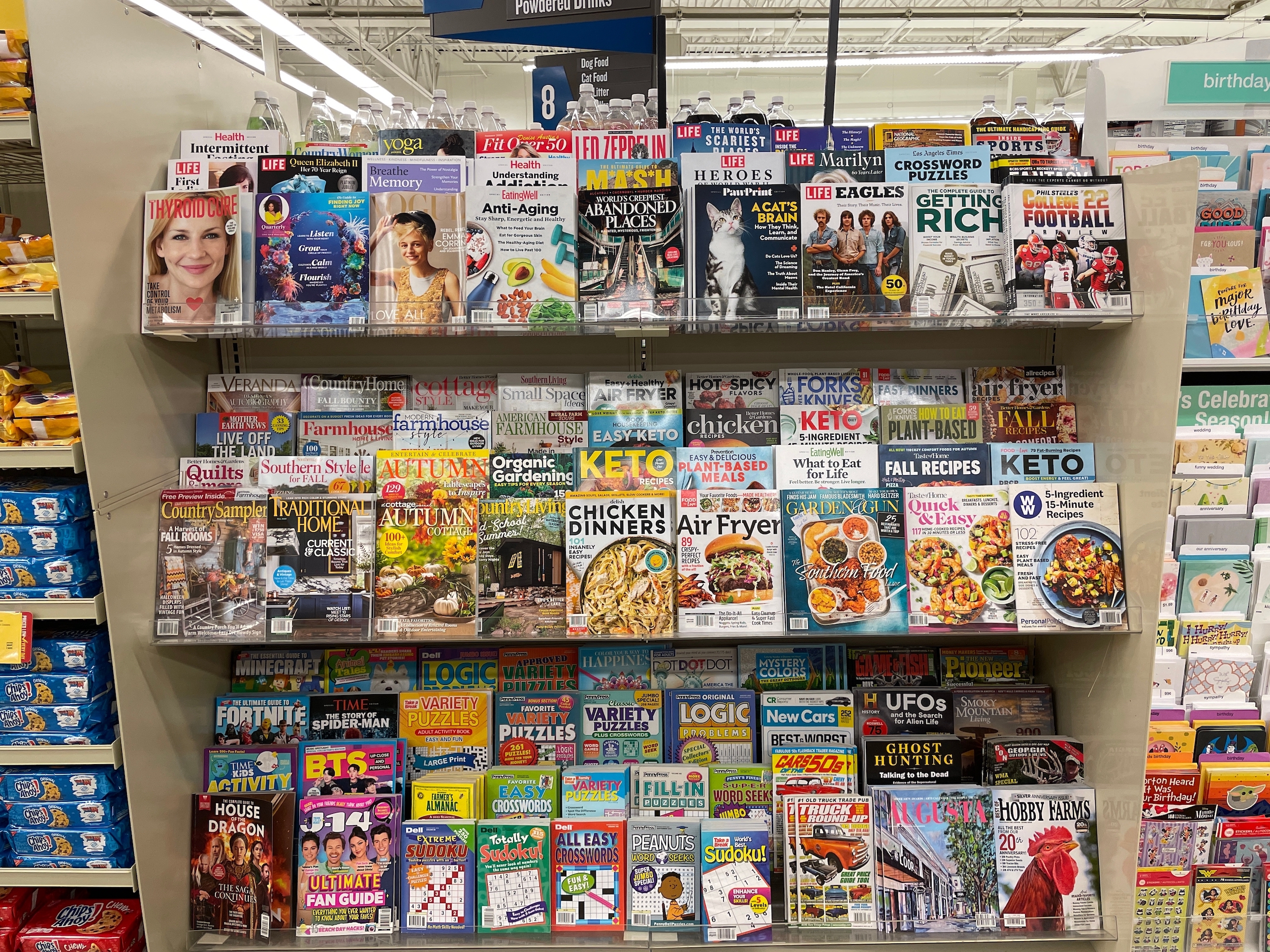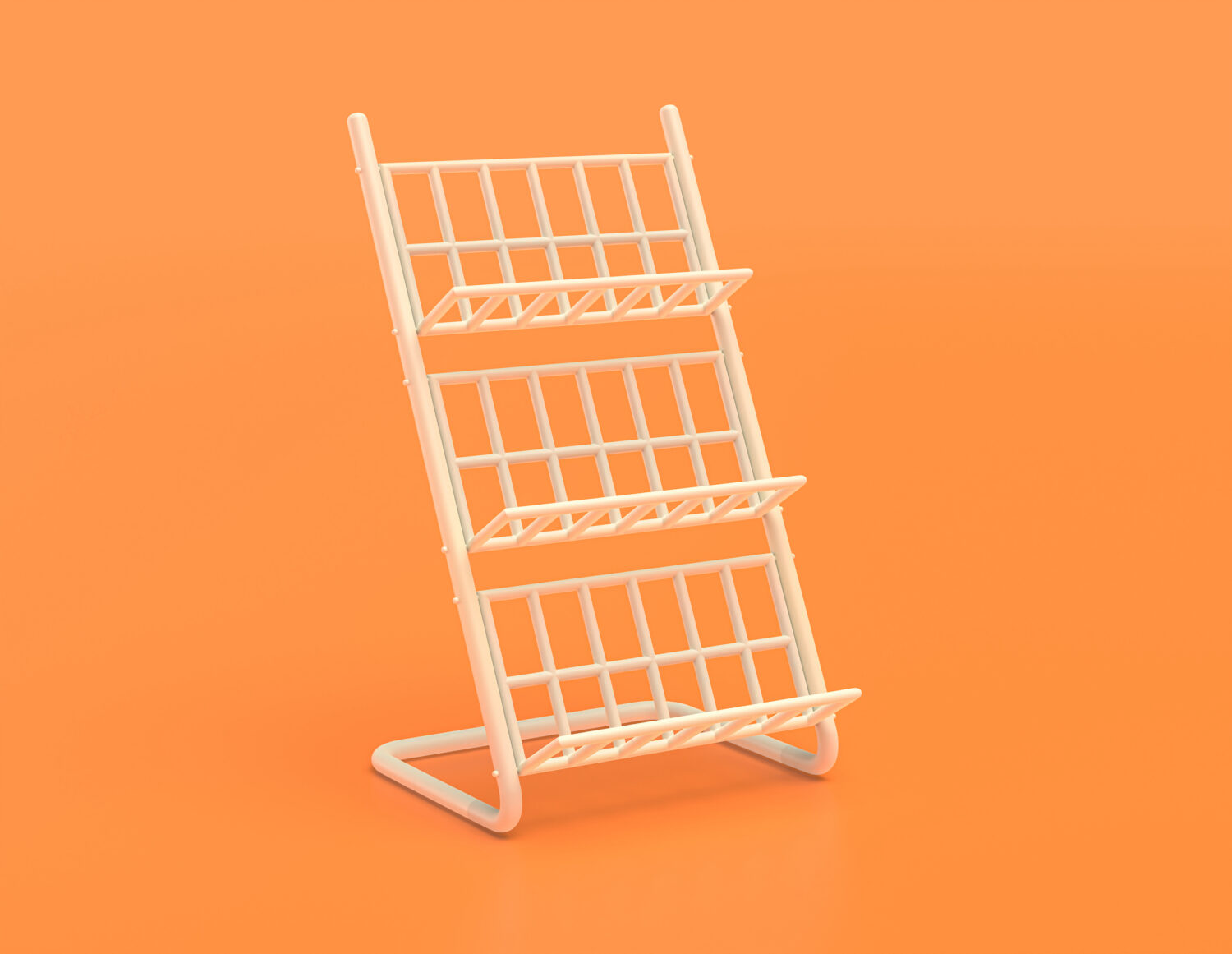In 2014 I wrote an obit for traditional newsstands in America — stores that sold mainly tobacco products and magazines — and about the birth of a new newsstand in grocery stores and bookstores. Tremendous change is now taking place at those new newsstands, which already look nothing like they did just a few years ago.
Though the newsstand was the most visible sign of a magazine, newsstand sales were never a major factor in the circulation strategy of the larger audited circulation publications. The strategic importance of newstands has only shrunk. Newsstand sales fell from a high 35% in the late 1970s to less than 10% in the early 2000s to a mere 3% of the total circulation today. A magazine like Time, which sells almost two million copies, now has very little presence on the newsstands. Overall, the newsstand industry went from about $6.8 billion in revenue in 2006 to about $1 billion in 2022 in a major drop following many changes that can be summed in one word: consolidation.
Consolidation took place in every segment of the magazine media business: publishers, printers, distributors, wholesalers and retailers. With no exception, and to various degrees of volume, each of those industries saw mergers and acquisitions resulting in fewer publishers, fewer printers, fewer distributors, fewer wholesalers and fewer retailers, which, in short, means fewer magazines available for the general public to pick up and buy at retail.
Reed Phillips, the managing partner of the investment bank Oaklins, the leading merger and acquisitions investment bank in the country, described the mergers as “an unprecedented level of consolidation.”
“These businesses have not been performing as well financially as they did in the pre-internet era,” he said. “The best way for the largest players in these industries, particularly public ones, to report growth and earnings improvements is to acquire smaller companies which they can combine with and reduce overhead and other operating costs that will make the acquiring company more profitable.”
Acquire they did: from the much-publicized acquisition of Meredith Corp. by Barry Diller’s digital giant IAC in 2021 (which now accounts for 27% of all newsstand revenue, according to COMAG, the only national distributor left) to a360media’s 2022 acquisition of Bauer Publishing Group and Centennial Group, two of the leading newsstand players in the country (a360media now accounts for 29% of all newsstands, according to the same source).
What’s notable about those acquisitions is they put the ownership of the two largest magazine media companies in the country today, Dotdash Meredith and a360media, under non-magazine owners for the first time in magazine media history. And, as Phillips said, their goal is “to report growth and earnings.”

A grocery store magazine rack in Grovetown, Georgia, on Jan. 15, 2023. (Shutterstock)
As traditional newsstands died, publishers hoped that supermarkets and bookstores would replace them and continue to make magazines available so the general public to buy single copies of their favorite publications. It worked until the pandemic hit and things quickly started to change. What are we missing without them?
“Newsstands are, from my perspective, mini-community centers,” said Bo Sacks, president and publisher of the Precision Media Group. “They provide readers access to important information. They offer a variety of newspapers, magazines and books that keep people informed about local and world events.”
Sacks adds, “Newsstands have a rhythm or a life cycle for the community. There was a healthy synergy between any city and its newsstands. They were in a fixed local location, and everyone had their favorite. They were reliable with your traditional publications or new publications, always there for the asking. As a customer, you knew when your magazine, newspaper, or comic book would arrive. Additionally, newsstands often sourced their products from local publishers, supporting the local economy.
“With the loss of thousands of newsstands across the country, we have diminished a once vital community communication tool that benefited the reading public,” Sacks said. “There is no digital replacement for newsstands as a community resource.”
That knowledge of where, and if, your magazine is at retail is rapidly changing. Eric Szegda, a360media vice president for consumer marketing and revenue, told me that branded frequency magazines (magazines that are published on a regular frequency, such as monthly or weekly) have become hard to find due to the changes taking place at retail, and it’s become a major problem.
“The status today generally has been a significant shift from the regular frequency core branded publication to the niche premium price bookazines,” he said. Customers vote with their pocket and the retailer is after that pocket. They care more about revenue than numbers.
The magazines on today’s newsstands can be divided into three categories, according to Steven Kotok, president of Kappa, one of the two major puzzle publication companies. They are traditional periodical magazines; special interest publications, better known as “bookazines;” and puzzle publications, which “are in a class by themselves,” Kotok said.
Traditional periodicals are “in rapid decline,” bookazines are “in rapid increase,” and puzzle publications are “holding steady,” he said.
MORE FROM POYNTER: Why every checkout counter in America sells those $14 magazines
How did those changes impact the consumer and their impulse purchases of magazines at the newsstands? That’s not quite the right question, Szegda said.
“The branded frequency publication was never a true impulse buy. True impulse is (when) you are checking out and you see a Snickers bar and all of a sudden you are craving a Snickers bar. For magazines, it is not a planned purchase but a planned consideration, especially for magazines like People and Woman’s World,” he said. “You shop at a regular store and consumer research shows that it is part of your routine, not necessarily to purchase People magazine every time you shop, but you will always consider People magazine and check it out. That’s why I tell editors I can get you the eyeballs but you need to create and design a magazine to convert those consumers to buyers.”
That “planned consideration” has shifted to what Szegda calls “passion point products or subjects.”
“When you spend $12.99 or $14.99 for a bookazine,” he said, “you have to be really passionate about what that subject matter is in order for you to spend that amount of money and tell yourself, ‘I am going to read every single page of that.’ 100% of the content should be relevant to me.”
That impulse buy is more about a consumer stumbling upon a bookazine that surprises and delights them, Szegda said.
“They did not know there is a special issue about the Titanic that is on sale,” he said. “They just saw it at the checkout counter for sale and it connected with them. The consumer will say to him/herself, ‘I am a total Titanic buff so I have to have this.’”
This change at the newsstands is “a reflection of what the consumer wants,” he said, in “an evolution away from the general interest mass appeal traditional magazines (weeklies and general interest magazines).”
Heightening that trend: Traditional monthly or bimonthly periodicals are losing their place at front-end checkout counters.
“As the front ends shrink,” Szegda said, “those monthly titles started to lose their display space first. And the first rule of sales on the newsstands is that if I can’t find the product I am not going to go out of my way to find it.”
That shrinking space at the supermarkets, convenience stores, drugstores and other retailers has made bookstores like Barnes & Noble and Books-A-Million — with 586 and 280 stores nationwide respectively — the place to shop for magazines. In fact, Alan Centofante, founder of Cover Rocket, an artificial intelligence tool to design magazine covers, calls Barnes & Noble “America’s newsstands.” Centofante wonders “why magazine publishers don’t promote the fact that people can find their magazines, and a lot of them, at the bookstore.”
Barnes & Noble carries between 1,500 titles in smaller stores and 2,500 in larger stores, said Krifka Steffey, Barnes & Noble’s director of merchandise. Steffey is in charge of approving and acquiring the magazine titles that make their way to the bookstore.
One-third of the titles in those stores are international titles, mainly from the United Kingdom. According to COMAG, Barnes & Noble stores used 3,625 bipads (sort of a social security number for a magazine title), with 9% of those for bookazines that account for 40% of revenue.
The problems, according to Steffey, are a dearth of innovation among publishers and an overall lack of retailers. “To be honest,” she said, “there is not a lot of creativity out there … everyone is playing it safe right now.”
That could be due to the skyrocketing cost of paper and printing, or because as the front end shrinks those monthly titles lost their display space first. The common denominator is that customers can’t find the product and they are not going to go out of their way to find it.
“The thing that also troubles me is that we’re not getting new retailers into our industry,” Steffey said. “We’re not picking up new spots.”
Magazine publishers are shrinking, too. What used to be launches of 100,000 and 125,000 copies, according to industry consultant Joe Berger, president of Joesph Berger Associates, “is now more like 10,000 and 12,500 launch instead.”
My own stats show that the annual number of new magazines has shrunk, too, from a high of 535 in 1996 to a low of 74 in 2022.
But Linda Ruth, an industry consultant and founder and president of PSC Consulting, said that the “special quality, special interest vertical publications are actually growing.”
“The newsstand has become a niche category,” Kotok said, with the high titles selling less than 300,000 copies an issue, a far cry from the 12 million copies that TV Guide used to sell in the late 1970s.
Correction: This article was updated to correct the spelling of Eric Szegda’s name.







